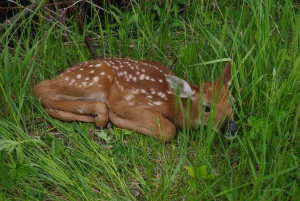 A thicket, a patch of tall grass and a quiet spot in your back yard – all places that fawns have been found. For the first few weeks of a white-tailed deer fawn’s life, its mother will hide it in secluded locations. This behavior helps reduce the potential of predators finding the fawn.
A thicket, a patch of tall grass and a quiet spot in your back yard – all places that fawns have been found. For the first few weeks of a white-tailed deer fawn’s life, its mother will hide it in secluded locations. This behavior helps reduce the potential of predators finding the fawn.
While fawns may seem abandoned, they rarely are. All wild white-tailed deer begin life this way.
A fawn’s spots are excellent camouflage and will help it stay hidden from predators. In addition to being hidden by its mother and having spotted camouflage, fawns have another adaptation to help them survive – they are virtually odorless when they are young.
If you find a fawn alone, do not touch it! There is a good chance it is supposed to be there. It is not uncommon for deer to leave their fawns unattended so as not to draw attention to where the fawn is hidden. The mother will return periodically to nurse her fawn when she feels it is safe.
The best thing to do is to leave the fawn alone and enjoy the experience from a distance. Leaving baby animals in the wild ensures they have the best chance for survival. Help keep Michigan’s wildlife wild.
Only licensed wildlife rehabilitators may possess abandoned or injured wildlife. Unless a person is licensed, it is illegal to possess a live wild animal, including deer, in Michigan.
 WLKM Radio 95.9 FM
WLKM Radio 95.9 FM
